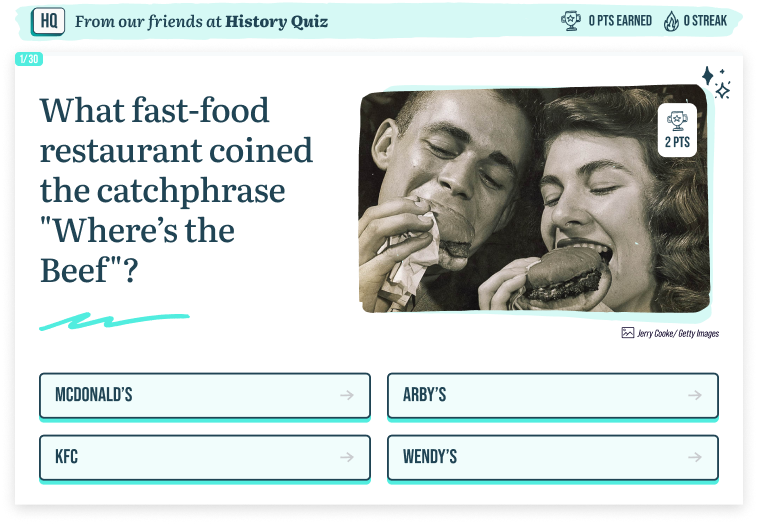
Maxwell House: “Good to the Last Drop”
A presidential urban legend has been percolating through Maxwell House headquarters for more than a century, citing President Theodore Roosevelt as the originator of their slogan, “Good to the Last Drop.” However, as with many other urban legends, the details are subject to debate.
Maxwell House debuted under the Nashville Coffee and Manufacturing Company moniker in 1901. There’s no disputing that in 1907, Roosevelt drank coffee during a visit to the Hermitage — the Nashville mansion President Andrew Jackson occupied for decades. But this is where the facts start to stray. Naturally, Maxwell House believed the commander-in-chief was enjoying their beverage at the mansion, but three more businesses made the same claim. According to a newspaper report, in between sips Roosevelt said, “This is the kind of stuff I like to drink, by George, when I hunt bears.” Yet after his 1919 death, Maxwell House advertised that Roosevelt had made a different declaration at the Hermitage, calling their java “good to the last drop.” Maxwell House retains the slogan today. Meanwhile, Coca-Cola takes credit for crafting the phrase during Roosevelt’s administration.

Wheaties: “The Breakfast of Champions”
Gold Medal Whole Wheat Flakes was an early name for Wheaties, which made its debut in 1921. At first, the product wasn’t very successful, but that all changed thanks to a fictional character named Jack Armstrong. During a neighborhood stroll, Sam Gale — the vice president of advertising at the cereal’s parent company, General Mills — realized that families weren’t basking outdoors because they were inside listening to the Washington Senators-New York Giants 1933 World Series. Wheaties began sponsoring baseball broadcasts and unveiled its own long-running radio adventure series, Jack Armstrong, All-American Boy. On the show, the protagonist and his playmate, Betty Fairfield, often exercised by playing tennis, golf, or basketball. Wheaties placed Armstrong on their print ads and also on a billboard at the Minneapolis Millers’ ballpark, integrating the tagline “Wheaties — The Breakfast of Champions.” In 1934, Yankees first baseman Lou Gehrig graced a Wheaties box, creating a pop-culture milestone athletes have repeated ever since.

De Beers: “A Diamond Is Forever”
In 1938, London-based De Beers tasked Philadelphia ad agency N.W. Ayer & Son with a challenge: Boost diamond sales. The Great Depression had hindered the sale of diamonds, which were already regarded as too luxurious for everyday Americans. However, the challenging part wasn’t selling more diamonds, but the parameters on how diamonds were marketed. Since De Beers controlled the global supply of rough diamonds, the company would violate U.S. antitrust laws if their name or photos of their jewels were promoted on any marketing materials, including newspaper and magazine ads. On an evening in 1947, Mary Frances Gerety, one of the few female copywriters in the industry, quickly jotted down, “A Diamond Is Forever,” and then fell asleep. Scientifically untrue, the line was first met with a tepid response, but Ad Age eventually christened Gerety’s work the slogan of the century. She wrote all of De Beers’ ads for the next 25 years. Ian Fleming even borrowed her signature sentiment for his fourth James Bond novel, Diamonds Are Forever.
More Interesting Reads

Volkswagen: “Think Small”
The Volkswagen Beetle was the first automobile model in history to sell 20 million cars. Much of that success is owed to its innovative American advertising agency, Doyle Dane Bernbach. During his first tour of a German Volkswagen plant, agency cofounder Bill Bernbach described the Beetle as “honest.” But before the brand fully embraced self-deprecation, sincerity became a tenet of the founding campaign. Helmut Krone, the co-writer of “Think Small,” was an early Volkswagen driver with German-born parents. In 1959, he and Julian Koenig rejected the swagger of American-made muscle cars, embracing a less-is-more philosophy that was echoed on a page of mostly negative space. Beetle ads were printed in black-and-white to save money, but the lack of color only underscored the message of simplicity.

Wendy’s: “Where’s the Beef?”
In 1984, Wendy’s contended that McDonald’s and Burger King exaggerated the size of their patties by stacking Big Macs and Whoppers. To enlighten fast food customers, R. David Thomas’ company greenlit a TV ad with a gruff octogenarian who called it as she saw it. Director Joe Sedelmaier delighted in the authentic delivery of untrained actors like 4-foot-10 Clara Peller, the veteran salon worker who barked “Where’s the beef?” as her friends noted a competing burger’s “big, fluffy bun.” The instantly quotable commercial aired for 10 weeks and supplied Walter Mondale with a presidential primary debate zinger. All Wendy’s locations saw at least a 10% growth in sales over the previous year. However, corporate executives had a cow when they saw Peller in a Prego spaghetti sauce spot, exclaiming, “I found it!” She never appeared in another Wendy’s ad.

Milk: “Got Milk?”
A candid focus group participant helped San Francisco creatives launch one of the most inescapable ad campaigns of the late 20th century. When brainstorming ideas for the California Milk Processor Board, executives at Goodby, Silverstein & Partners asked focus group attendees to abstain from milk for a week prior. One man recapped his experience readying the perfect bowl of cereal — only to realize he had to skip a key ingredient. The anecdote’s responses convinced the agency that people feel emotionally attached to milk, a theory they tested by emptying cartons in the office refrigerator, then hiding a camera to gauge reactions. “Got Milk?” arose in 1993 from the observed fear of running out. Michael Bay and Annie Leibovitz both shot ads, which often sported celebrities with milk mustaches. Today’s average American downs 18 gallons of milk per year, a 40% drop from 1970.












